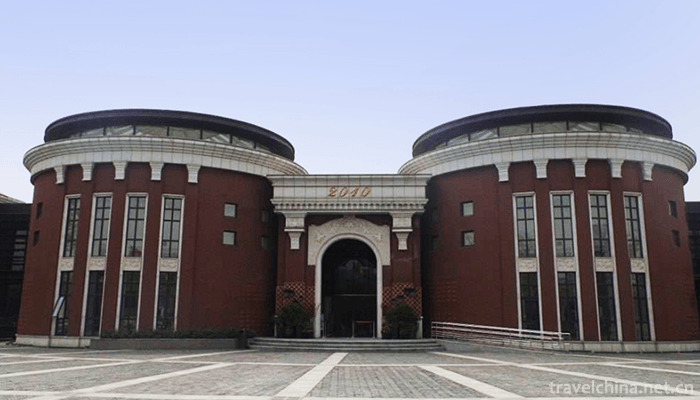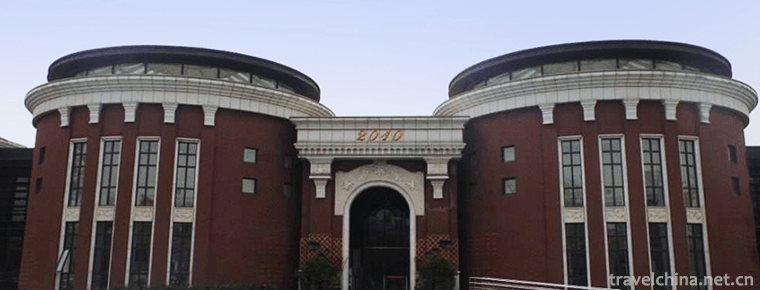Shanghai Baoshan International Folk Art Exhibition Hall
Shanghai Baoshan International Folk Art Exhibition Hall is the first exhibition, research and protection of intangible cultural heritage in Shanghai constructed by Shanghai University in cooperation with Baoshan Government. It is also the largest exhibition hall of intangible cultural heritage in the world in China. Shanghai Baoshan International Folk Art Exhibition Hall is located at Gate 1 of Gucun Park at the junction of Shanghai-Tai Road and Outer Ring Road, with a building area of 14600 square meters. The architectural design concept of the Expo Hall is derived from the folk cultural image of "Chinese knot". Its overall layout is an integral whole, which is a true "cultural Grand View garden".
building structure
Shanghai Baoshan International Folk Art Exhibition Hall is a two-storey building structure. The first floor exhibition hall covers an area of about 3000 square meters, with a total of eight exhibition halls. "Preface Hall" mainly displays the dragon boat of Luodian in Baoshan and the traditional folk culture elements in this area; and "Sea Baoshan Hall" is divided into four units. The first unit takes "Dragon Boat Race" as the scene, vividly demonstrates and reproduces the history of dragon boat culture and the lively competition scene of Shanghai Baoshan Dragon Boat Festival. The second unit takes "Wanjia Lantern" as the line, and clearly outlines the development process of Baoshan Folk Lantern art. The third unit takes "Talking and Singing Baoshan" as the point, comprehensively introduces the local culture such as folk entertainment and rap deeply rooted in Baoshan's native land; the fourth unit takes "Colorful Art Festival" as the color, carefully decorates the beautiful picture scrolls of the six Baoshan International Folk Art Festival. "China Hall" also has four sketches. "Shili Red Makeup" conveys Chinese traditional wedding culture, "opera interpretation" interprets Chinese traditional opera in the form of multi-media, "local voice is difficult to change" shows the characteristics of Chinese local languages and ethnic groups, "Manchu and Han Full Seat" takes solar terms as the axis, linking up to show the Chinese traditional diet culture and exquisite production technology.
"Asia-Pacific, Africa, Middle East, Latin America, Europe and the United States" and other five exhibition halls vividly show the culture of five continents and the customs of the four seas. There is a multi-functional hall and two indoor courtyards on the first floor of the Expo Hall. It is understood that this area can be used as a temporary exhibition hall in the future to hold art exhibitions with specific themes, as well as for small-scale performances or international activities. There are also six temporary exhibition halls on the second floor of the Expo Hall, which are connected by a T-shaped corridor. They are mainly used for holding various thematic exhibitions. There are also glass, ceramics and weaving workshops in the museum, which will become the research and teaching base of International Folk art. The museum also has Research Institute studios, laboratory classrooms, projection halls (lecture halls) and other functional areas, as well as open-air theatres, open-air exhibition areas and other outdoor venues.
Influence
Shanghai Baoshan International Folk Art Exhibition Hall is a public welfare cultural facility integrating collection, exhibition, exchange, research and social service functions, and devotes itself to the exhibition and exchange of Chinese and foreign folk art. It combines with Baoshan International Folk Art Festival to carry out multicultural activities, and it has become a window for Baoshan's external exchange, Shanghai intangible cultural heritage protection and research center. Shanghai Baoshan International Folk Art Festival is a large-scale activity center. The Expo Hall has been listed in the list of China's intangible cultural heritage which has been officially promulgated and protected. It focuses on Shanghai's intangible cultural heritage projects, supplements international folk art exchanges and exhibitions, and highlights the splendor of multiculturalism. After the opening of the museum, Shanghai University and Baoshan District cooperated closely to strengthen exchanges in the research, protection, development and reuse of intangible culture and make contributions to folk culture and art.
Tourist guide
The opening time of Shanghai Baoshan International Folk Art Expo is from 9:00 to 16:00 every Tuesday to Sunday, and it is closed on Monday. With the approval of the price department of Baoshan District, the ticket price of Shanghai Baoshan International Folk Art Exhibition Hall is 30 yuan per person. Ticket price preferential measures in accordance with the "Shanghai Tourist Visiting Points Ticket Price Management Measures": for children under 1.2 meters, active servicemen, disabled soldiers, family members of martyrs, retired cadres, the elderly over 70 years old, disabled persons to exempt tickets; students with student certificates (student ID card) 15 yuan per person.
In September 2015, at the initiative of China Tourist Scenic Area Association, Shanghai Baoshan International Folk Art Exhibition Museum signed the promise of "no increase in ticket prices".
service content
In addition to the explanation service, the museum also has a digital language guide system. After debugging, it can introduce the exhibits in Chinese and English, as well as in French, Japanese and Spanish. As long as you press the button and input the code, you can hear what you need to explain.
Mailbox, Wifi Internet access, coin phone, wheelchair crutches and other convenient services are also set up in the service area.
In addition, the museum also provides visitors with consultation, goods storage, parking and other services.


-
1.Expo Area of Acient Kiln & Folk Cultures in Jingde
Jingdezhen Ancient Kiln Folklore Expo Area, located in Fengshu Mountain and Panlonggang, Changjiang District, Jingdezhen City, Jiangxi Province
Time 2018-12-08 -
2.Qingming Bridge Ancient Canal Scenic Area
Qingming Bridge Ancient Canal Scenic Area is located at the southern end of Wuxi city center, covering about 44 hectares of scenic area. The scenic spot is composed
Time 2019-02-07 -
3.Wulingyuan
Wulingyuan Scenic Spot is located in the northwest of Hunan Province, central China. Its longitude is 110 20'30 ~110 41'15 and latitude is 29 16'25 ~29 24'25
Time 2019-02-24 -
4.Huai Bang
Huai Bang (also known as Huai Diao, commonly known as Huai Qing Bangzi, Lao Huai Bang, Xiao Bang Opera and Xiao Ban Opera), is one of the traditional local operas in Henan Province and one of the nati
Time 2019-05-04 -
5.The Construction Skills of Hui School Traditional Dwellings
The construction techniques of Hui traditional dwellings are the traditional wood structure construction techniques with rich local characteristics. The legend of woodworking techniques is written bet
Time 2019-05-04 -
6.Hui Costume
The main symbol of Hui costume is the head. Men like to wear white caps. Hui women often wear a hood. Older Hui women wear black or brown headscarves in winter
Time 2019-05-04 -
7.Firing Techniques of Jizhou Kiln Ceramics
Jizhou kiln is a treasure of the traditional Chinese ceramic crafts. As a world-famous comprehensive ceramic kiln in Jiangnan (Ji'an, Jiangxi), it has strong local style
Time 2019-05-05 -
8.Scissors Forging Technology
Zhang Xiaoquan scissors forging technology, local traditional handicraft in Hangzhou, Zhejiang Province, one of the national intangible cultural heritage.
Time 2019-05-05 -
9.Salar Costume
The traditional dresses of the Salar nationality are bright and bright in color and full of national characteristics. Salar costumes have two characteristics, namely (1) Islamic color of costumes; (2)
Time 2019-06-11 -
10.Zuoquan Xiaohua Opera
Zuoquan Xiaohua Opera is a kind of Han folk song and dance drama which originated in Zuoquan County of Shanxi Province and spread in Yushe and Heshun areas near Zuoquan County. Its style is: one step
Time 2019-08-16 -
11.Administrative division of Panzhihua
Panzhihua City has 5 county-level administrative divisions (Municipal District 3, county 2) and 49 township level administrative divisions (street 11, town 23, township 15). It covers an area of 7440 square kilometers and has a population of 1.12 million. Panzhihua Municipal People's government is located at No. 2, bingcaogang street, East District.
Time 2020-12-14 -
12.medical and health work
By the end of 2019, there are 2139 medical and health institutions with 19943 beds. At the end of the year, there were 14351 technical personnel in hospitals and health centers, including 4839 licensed doctors and 6767 registered nurses. The numbe
Time 2020-12-18